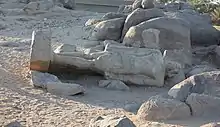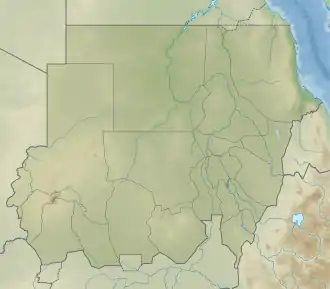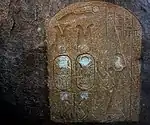Tombos (Nubia)
Tombos or Tumbus is an archaeological site and an island in northern Sudan. The village and the island are located at the third cataract of the Nile, not far from Kerma near the present Karmah.
 | |
 Shown within Sudan | |
| Location | Sudan |
|---|---|
| Region | Nubia |
| Type | Settlement |
| Site notes | |
| Condition | In ruins |
| Website | tombos |
A large range of pharaonic and private rock inscriptions were carved at Tombos during the Eighteenth Dynasty of Egypt when the site marked an important boundary between Nubian and Egyptian interaction.[1][2][3]
An important black granite quarry was located at Tombos in the pharaonic era. Its stone was used mostly to build statues and buildings between the river delta and the southern regions of the kingdom. Its most prominent feature is a statue of a pharaoh of the Twenty-fifth Dynasty of Egypt, abandoned for over 2700 years.[4]
In 1991, a survey of the University of Khartoum revealed the remains of an important Egyptian colonial cemetery of New Kingdom date. In 2000, Stuart Tyson Smith of the University of California, Santa Barbara and his team excavated the remains of a pyramid more than 3,500 years old, and the buried remains of an Egyptian colonial administrator named Siamun and his mother, Weren. The two intact mummies were buried with ushabti figurines, a boomerang, and painted Mycenaean terracotta.[5] The burial chamber includes a series of rooms, some plundered by thieves, while others were undisturbed in whole or in part. Also, an epigraphic survey by the British Museum uncovered pharaonic rock-inscriptions.
See also
References
- Julia Budka; The Third Cataract. Its Historical and Political Importance according to Royal and Private Rockinscriptions at Tombos Retrieved 1 November 2018.
- W.Vivian Davies; Tombos and the Viceroy Inebny/Amenemnekhu Retrieved 1 November 2018.
- W.Vivian Davies; The British Museum epigraphic survey at Tombos: the stela of Usersatet and Hekaemsasen Retrieved 1 November 2018.
- Tombos. A New Society on the Egyptian Frontier Retrieved 1 November 2018.
- "Tombos Excavation". University of California, Santa Barbara. Retrieved 3 August 2012.
Further reading
- "Siti del Nuovo Regno e Kushiti nella regione della terza cateratta, Nubia sudanese", Edwards, D. & Ali Osman. 2001
- "Tombos and the Transition from the New Kingdom to the Napatan Period in UpperNubia," 2006, Plenary Session, The 11th Conference of Nubian Studies, Warsaw University – Poland
- "Colonial Entanglements: The UCSB Excavations at Tombos and the Third IntermediatePeriod in Upper Nubia” 2005, American Research Center in Egypt (ARCE), Boston
| Wikimedia Commons has media related to Tombos (Nubia). |

